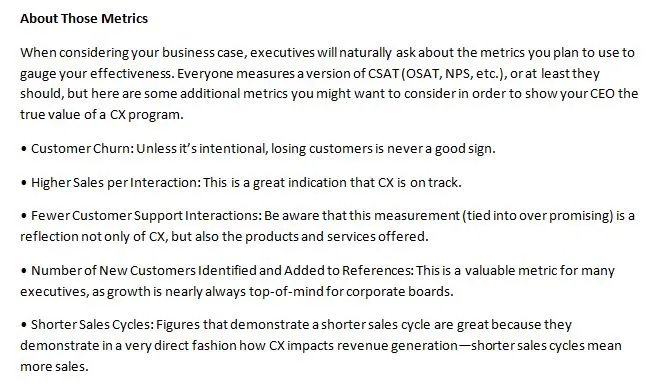What You Can Do When the CEO Says “No” to Your CX Business Case
Customer experience requires funding and funding requires a strong business case. So how do you draw a direct connection between your efforts and the business resources needed to sustain them?
Whether you are a seasoned practitioner or a relative newcomer, just beginning a new program, or refining the next level of organizational improvement, chances are that you’ve been asked to demonstrate the business impact of the customer experience program.
First you spent a lot of time masterfully outlining how industry-leading customer satisfaction would be achieved by drawing on the latest research and best practices. This impressive plan will ensure the support of the executive team, you told yourself.
After all, asking for funding is merely a formality, right? Who wouldn’t support an investment in happier and more loyal customers? And your executive sponsor supports your ideas about the importance of building a customer-centric culture—until now. Your plan came back with some encouraging comments, but without the requested funding.
When I talk with other CX practitioners about challenges they are facing, the above scenario is not unusual. In fact, I experienced this early in my career and learned some basics that I still use today.
I had just been asked to lead my first customer experience program and was familiar with putting together a business case. When I managed customer service, I went through the same exercise and knew that I would probably receive 90-95% of requested funding. So, when I received no funding for the CX program, I was mystified and decided to find out why.
My first stop was my direct manager, the CEO. I asked him a couple of questions that focused on whether the business case was complete enough. He assured me that it was technically well-written but that it was competing with a lot of other requests from other departments. So far, I had not learned anything new. But, then, he said something that captured my attention. He said that other proposals included a shorter term return on investment. While my business case showed the benefits of increased customer satisfaction over the next 3 years, other plans demonstrated ROI in a much shorter time frame.
My next stop was the chief financial officer. Already aware that the financial section needed to include not only long-term, but also short-term benefits, I asked him if there was anything else that led to the decision not to fund the program. He said that while he supported an increase in customer satisfaction, he didn’t understand the difference between customer experience and customer service. Wasn’t he already funding customer service, and wasn’t that enough to increase customer satisfaction?
The alarm bells went off in my head and I realized that I had not spent enough time educating each member of the executive team about the unique value an enterprise customer experience program delivers.
I learned so much from those two meetings that I set up meetings with each member of the executive team and received valuable feedback that influenced how I construct a business case. We all know that a strong business case is, and should be, considered mandatory. You can find a lot of information online about which sections to include, but I found that, besides the standard sections on financial metrics, goals and milestones, there is much more that goes into writing a plan that secures funding for customer experience.
So how do you do it? By asking a few pivotal questions and remembering several key points, you can build a business case that is effective and convincing. Just follow the steps below:
Build an Effective Business Case
- Pinpoint the pain. Do your proposed efforts complement the priorities of the business? The CEO or senior executives who ultimately provide you with funding have their own worries, which you must keep in mind. Before presenting any CX initiatives, ask yourself some basic questions. What’s keeping my CEO and board up at night? Are the initiatives I’m proposing relevant, and if not overtly so, can I effectively show a direct correlation? In the absence of this relevancy, you will lose busy executives’ attention.
- Include the Right Information. Corporate leaders receive a steady stream of proposals, but you can stand out from the crowd by including the right information in an easily digestible format. Include, in clear terms, the problem the CX initiative aims to address, the benefits and/or results it will deliver, the resources required, and the return on investment (ROI) expected. Short- and long-term ROI is key. The business case should also show why the CX initiative is needed now. Senior executives can be tempted to postpone efforts that lack an element of urgency.
- Be prepared to measure your effectiveness. You probably won’t have metrics to draw on at the start, but be prepared to let executives know in advance what metrics you plan to use, including some that can be tracked long term, while also explaining why having them will be a benefit in and of itself. Whenever possible, also note why and how CSAT correlates to business success.
- Don’t overpromise. The setting of unrealistic expectations can quickly poison even the best CX plans and it’s one of the most common mistakes CX practitioners make. Executives need to be reminded that it took years to get to the current state, and you can’t undo longstanding systems, processes or an established company culture overnight.
- If you are turned down, ask why, then ask why again. Executives understandably often give the most expedient answer. For example, “it’s not in the budget” doesn’t necessarily mean funding is lacking. Often times it’s simply the easiest way to say no without giving details. You need to find out what really is behind their decision. The real answer might be something you can help address with alternative CX initiatives and plans.
My first lesson was a tough one. I didn’t receive any funding that first year but the work still had to be done to mature the program and demonstrate its value. The following year my learning points were put into action and I developed a compelling business case. I’d like to say that I received 100% of requested funding but it was significantly less. It took about 4 years before the funding was at the level that I had originally requested.
 Some might say that making appointments with each executive to educate and inform, developing a meticulous business plan with both short and long term benefits—all while building an enterprise wide customer experience program—is more than other, more traditional areas of the business would be required to do.
Some might say that making appointments with each executive to educate and inform, developing a meticulous business plan with both short and long term benefits—all while building an enterprise wide customer experience program—is more than other, more traditional areas of the business would be required to do.
But consider that, for many organizations, customer experience is a new initiative. While head-nodding occurs when the benefits of customer loyalty are discussed, only well understood and supported programs receive funding.
The good news is that if you keep these straightforward ideas in mind, your business plan will secure the required resources.
This article original appeared in Customer Think on August 3, 2016.
The post What You Can Do When the CEO Says “No” to Your CX Business Case appeared first on Customer Experience Management Blog.